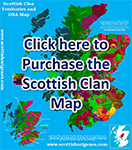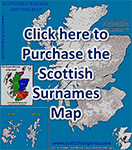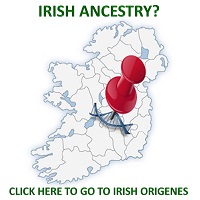You are here
Putting some Leaves on the M222 SNP Tree
Step I: When the Gaelic surname 'MacMichael' becomes Norman 'Mitchell'
A change in ‘cultural identity’ can be quite rapid (think modern Americans who are a mix of almost every nation on the planet) or it can be slow as demonstrated in the Mitchell Case Study which can be downloaded and studied by clicking here. 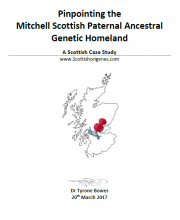 Today, upon commercial ancestral DNA testing males that carries the R-M222 paternal genetic maker will be of American (including African American), Canadian, Australian, and of course of Irish or Scottish origin (to name but a few). Yet they are all the descendants of ‘Celts’ who lived in Mainland Europe and who began arriving in waves into Britain and Ireland from about 800BC onwards. Their Celtic ancestors would have been indistinguishable from those described by Julius Caesar, and their spread into Britain and Ireland almost completely changed the genetic makeup of both islands, virtually replacing the pre-historic inhabitants (think European impact on the Native Americans). By 500AD the founding ancestor of R-M222 was living near the ancient structure of Aileach near the modern City of Derry/Londonderry in the far Northwest of Ireland. A relatively short time after the R-M222-Adam lived, some of his descendants had spread overland through the Ancient Irish Kingdom of Breifne (Leitrim/Cavan), and into Westmeath and as far south as the Galway and Tipperary borderlands, where they would later contribute to ancient Irish Clans like the O’Reillys, Whelehans, O’Mannions and McEgans.
Today, upon commercial ancestral DNA testing males that carries the R-M222 paternal genetic maker will be of American (including African American), Canadian, Australian, and of course of Irish or Scottish origin (to name but a few). Yet they are all the descendants of ‘Celts’ who lived in Mainland Europe and who began arriving in waves into Britain and Ireland from about 800BC onwards. Their Celtic ancestors would have been indistinguishable from those described by Julius Caesar, and their spread into Britain and Ireland almost completely changed the genetic makeup of both islands, virtually replacing the pre-historic inhabitants (think European impact on the Native Americans). By 500AD the founding ancestor of R-M222 was living near the ancient structure of Aileach near the modern City of Derry/Londonderry in the far Northwest of Ireland. A relatively short time after the R-M222-Adam lived, some of his descendants had spread overland through the Ancient Irish Kingdom of Breifne (Leitrim/Cavan), and into Westmeath and as far south as the Galway and Tipperary borderlands, where they would later contribute to ancient Irish Clans like the O’Reillys, Whelehans, O’Mannions and McEgans.
However, the most notable spread of R-M222 males began with the arrival of the Vikings in Ireland, whose cutting edge seafaring technology allowed the Gaels of Northwest Ireland to spread into what would become ‘Galloway’ in Southwest Scotland in 1100AD. The Irish Gaels took with them to Southwest Scotland their surnames (Mac), language (Gaelic) and their genetic markers (like R-M222). But by 1600AD they had completely changed! English had become their primary language (Gaelic would be extinct in Southwest Scotland by 1760AD), and although they remained Christian they were now Protestant rather than Catholic, and they regarded themselves as Lowland Scots rather than ‘Foreign Gaels’ (Galloway means ‘land of the foreign Gael,’ Galloway was incorporated into the Kingdom of Scotland in 1240AD). However, their distinctive genetic markers (most notably R-M222) remained in the local population, as did their distinctly Gaelic surnames. But, their surnames were not immune from change; with essentially all Gaelic surnames being extensively anglicised! The Mitchell case study illustrates this quite beautifully. Mitchell is a Norman surname common throughout Britain and Ireland, yet the test subject carries the Gaelic R-M222 marker and his DNA places his paternal ancestry among the Irish colonisers of Galloway. By studying his genetic matches it demonstrates how his paternal ancestor moved from the Gaelic world of Galloway into a Norman area of Central Ayrshire, which also corresponded to his ancestor either willingly or unwillingly changing his surname from Gaelic-MacMichael to Norman-Mitchell. In fact his most recent (Scottish) paternal ancestral genetic homeland lies in an area where Mitchells and MacMichaels live (and farm) side by side. Scottish Lowlander Mitchells and MacMichaels would continue to have lived oblivious to their common ancestry if not for modern DNA science.
Step II: Putting some Leaves on the M222 SNP Tree
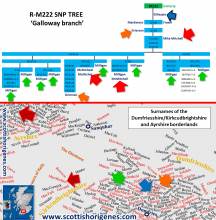 Mr Mitchell has also undergone BigY 'SNP' testing and his branch appears on one such R-M222 SNP tree (see top panel attached image). My pet hate with those types of SNP ‘trees’ and their branches is the distinct lack of ‘leaves’ (or rather 'locations'). These SNP trees rarely detail the ancestral origin of the individuals that they feature. Yet my analysis has shown that Mike Mitchell's paternal ancestors landed in Galloway in about 1100AD, eventually exchanging Gaelic 'MacMichael' for Norman ‘Mitchell’ in Central Ayrshire (see bottom panel). In fact an examination of the surnames of his shared branch of the R-M222 SNP tree (top panel) reveals that 50% of those surnames are associated with Southwest Scotland, with MacMichael (red arrows) and Grierson (orange arrows) being exclusive to this area (they appear in red font on the Scottish Origenes Surnames map; which means that farmers with those surnames appear nowhere else within Scotland).
Mr Mitchell has also undergone BigY 'SNP' testing and his branch appears on one such R-M222 SNP tree (see top panel attached image). My pet hate with those types of SNP ‘trees’ and their branches is the distinct lack of ‘leaves’ (or rather 'locations'). These SNP trees rarely detail the ancestral origin of the individuals that they feature. Yet my analysis has shown that Mike Mitchell's paternal ancestors landed in Galloway in about 1100AD, eventually exchanging Gaelic 'MacMichael' for Norman ‘Mitchell’ in Central Ayrshire (see bottom panel). In fact an examination of the surnames of his shared branch of the R-M222 SNP tree (top panel) reveals that 50% of those surnames are associated with Southwest Scotland, with MacMichael (red arrows) and Grierson (orange arrows) being exclusive to this area (they appear in red font on the Scottish Origenes Surnames map; which means that farmers with those surnames appear nowhere else within Scotland).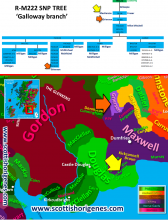 The Scottish Origenes Clan Territories map features over 400 of the most prominent Scottish Clans and Families. Research at Scottish Origenes has revealed that the Y-DNA test results will often reveal shared paternal ancestry with one or more of the prominent Clans and Families that once ruled over one's paternal ancestral genetic homeland. An examination of Dumfriesshire reveals both the MacKenzies (yellow arrows) and Griersons (orange arrows), who also appear on his branch of the R-M222 SNP tree. Over time, as more and more people participate in BigY SNP testing, more ‘leaves’ (locations) will be added to the bare branches of the M222 SNP tree. If you believe that you may be related to Mike Mitchell then you can contact him: ojsglty
The Scottish Origenes Clan Territories map features over 400 of the most prominent Scottish Clans and Families. Research at Scottish Origenes has revealed that the Y-DNA test results will often reveal shared paternal ancestry with one or more of the prominent Clans and Families that once ruled over one's paternal ancestral genetic homeland. An examination of Dumfriesshire reveals both the MacKenzies (yellow arrows) and Griersons (orange arrows), who also appear on his branch of the R-M222 SNP tree. Over time, as more and more people participate in BigY SNP testing, more ‘leaves’ (locations) will be added to the bare branches of the M222 SNP tree. If you believe that you may be related to Mike Mitchell then you can contact him: ojsglty
What will your DNA reveal? If you have not taken a commercial ancestral DNA test but wish to find out what your DNA will reveal then contact Scottish Origenes here (I'll recommend a suitable test). Or if you would like a FREE CONSULTATION on your DNA results then contact Scottish Origenes here.
Remember folks, your DNA test results are generated in a scientific lab, using complex scientific equipment and trained scientists. Interpretation of your scientific results should always be left to a professional scientist. ALWAYS CHECK THAT YOUR GENETIC GENEALOGIST HAS A SCIENTIFIC QUALIFICATION! IT WILL SAVE YOU BOTH TIME AND MONEY!
Author; Dr. Tyrone Bowes, November 2017


